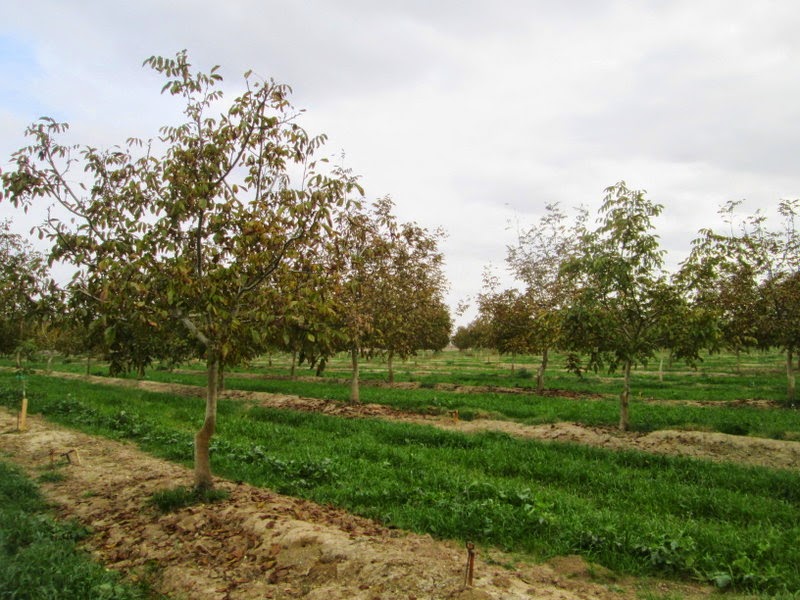So recently I went down to Florida on a fertilizer mission to check on some important field investigations. I was accompanied by AgroLiquid chemist Chris, and we were met by Field Agronomist Mike and Area Sales Manager Jim Dorman. I have been reporting on the sugarcane field tests we have down in South Florida for over a year now. The picture below shows how one area looked back on November 13, 2013. It was planted around six weeks earlier. I remember that it was cool and cloudy that day.
And here is the same area as it looked on this November 18, almost exactly a year later. The cane is over 10 feet tall now. It's still green on the field edges, but go in a little and the leaves are turning brown and the cane is firm and ready for harvest. It was also very cool and cloudy with rain when we were there again this year. Although the weather back in Michigan that day was very cold and snowing. So it was alright getting a little wet.

I found it's hard to capture the perspective with the camera. But you can see the cane stalks standing up there. The harvest season stretches from October to April with nearly 200,000 acres running through the mill in Clewiston. It is the large number of acres and the single mill that controls when a particular area is to be harvested. But when it is time, the field will be burned to remove the dead leaves, with the stalks remaining to be collected and taken to the mill. I have seen this burning operation from a distance. At first I thought it would be a long and slow process like a forest fire. But it is really fast, since just the leaves burn. It does create a lot of smoke and I wonder how that is perceived by the public. But that's the only way to get the cane out of the field. It will also be a challenge for the company field personnel to keep track of the yields from the different treatment blocks of our nearly 1000 acre experiment. But we have been assured that it would happen. Sounds good to me.

Here we see Chris satisfying his sweet tooth while Mike makes sure he doesn't go overboard on it. By the way, Chris is wired up for a meeting back in St. Johns. Hope they didn't hear him slurping up the sugar.
We also had the opportunity to stop by Jim's blueberry farm to show us how he meters fertilizer into the irrigation drip lines in the field. Fertilizer is sucked from that recessed ground tank into the main water lines using a venturi effect. This is where the pressure of water passing through the big pipes creates suction to draw fertilizer from the tank. Mike is certainly intrigued.
Jim hopes to be transplanting the blueberry plants soon, but heavy rain is holding that off for awhile. Here Chris watches water being pumped from the field into a drainage basin. He also is being reminded that he shouldn't have had so much coffee for breakfast.

We also wanted to follow up on some orange projects with some growers. Many people are not aware of the devastating disease affecting citrus trees on a world-wide basis. It is called citrus greening or HLB disease. It is a bacterial disease that clogs up the phloem of citrus trees. The vector is an insect called the Asian Citrus Psyllid. It feeds on the leaves and infects the plants. There is no known control, and they have really been trying. Of course on way is to control the psyllid by spraying, but this hasn't really stopped it. It is really making growing oranges tough for growers, and has affected price as this picture taken in a grocery store by Mike attests. The sign says it has affected "50% of the citrus crop". But I understand that it is nearly on the total crop in Florida.
Here is the symptom on the leaves. They are mis-shapen and chlorotic.
The affected fruit is lighter green (vs orange, or orange green), there is fruit drop, and it can lead to death and tree removal. We saw some small re-planted trees that were already infected. One strategy being tested is to load up the tree with nutrition, especially micronutrients, in order to keep the phloem open. This isn't a cure but more of a coping mechanism.
We visited several juice orange groves that have received both drip and foliar applications of AgroLiquid nutrition. Like this one below. There are still the yellowed leaves, but it appears that production is still going to be good. We saw few dropped oranges. Of course, the grower will let us know after harvest, which should be soon. We have some comparison treatments that will hopefully help guide us towards some relief for this terrible disease.
As you can see here, the inside of the orange looks fine. And it certainly passed my taste test.
So my visit to the Sunshine State was very worthwhile with the crop updates, some good food and as we just saw, oranges. The only thing missing was the Sunshine. But I'll be back.





























